Navratri, a vibrant and spiritually significant festival, is celebrated with fervor and enthusiasm across India. The word “Navratri” is derived from two Sanskrit words: “Nav” meaning nine and “Ratri” meaning night. Hence, Navratri spans nine nights and ten days, celebrated to honor the divine feminine energy and to commemorate the victory of good over evil. This article explores the deep-rooted significance of Navratri, the traditions observed during these nine days, the delectable dishes that are savored, and answers to frequently asked questions about this auspicious festival.
Historical Significance
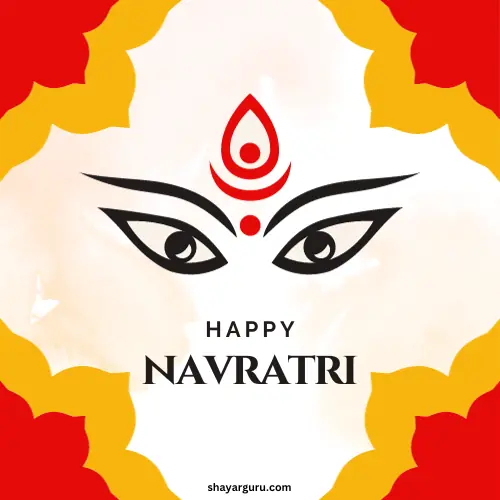
Navratri has deep historical roots in Hindu mythology and legend. It is believed to commemorate the victory of Goddess Durga over the demon Mahishasura, who symbolizes evil and tyranny. The nine nights of Navratri represent the nine divine forms of Goddess Durga, each of which represents a different facet of her power.
Also read: Navratri Wishes
Different Types of Navratri
While the most well-known Navratri is celebrated in the autumn (Sharad Navratri), there are actually four Navratris celebrated throughout the year. These include Chaitra Navratri, Ashad Navratri, Sharad Navratri, and Magha Navratri, each with its unique significance and observances.
The Nine Forms of Goddess Durga
During Navratri, devotees pay homage to the nine forms or manifestations of Goddess Durga:
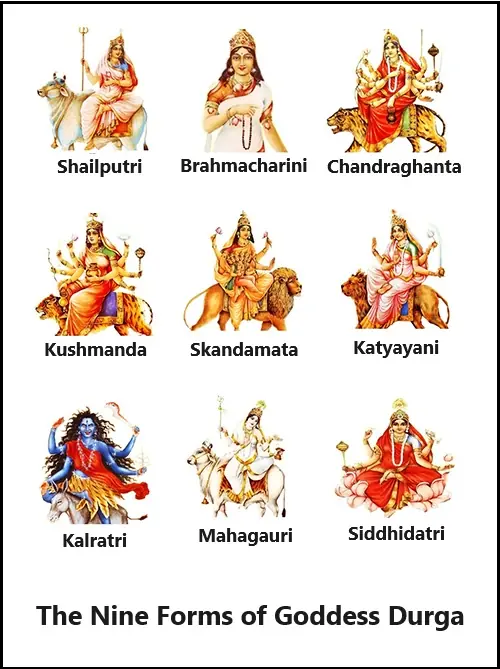
- Shailputri: She is the daughter of the Himalayas and represents purity.
- Brahmacharini: The unmarried form of the Goddess signifies penance and devotion.
- Chandraghanta: This form symbolizes bravery and grace.
- Kushmanda: The creator of the universe, she represents creative energy.
- Skandamata: The mother of Lord Kartikeya, she embodies the bond between a mother and child.
- Katyayani: A fierce warrior, she symbolizes courage and valor.
- Kalratri: She is a fearsome form representing destruction of evil.
- Mahagauri: A symbol of purity and serenity.
- Siddhidatri: She bestows knowledge and supernatural powers.
Spiritual Significance
Navratri holds immense spiritual importance. It is a time for devotees to seek the blessings of Goddess Durga for strength, wisdom, and protection. The festival also signifies the triumph of good (Goddess Durga) over evil (Mahishasura), emphasizing the eternal battle between righteousness and wickedness.
Preparations and Cleanliness

The preparations for Navratri begin weeks in advance. Homes are thoroughly cleaned and adorned with colorful decorations and flowers. Devotees buy new clothes and jewelry for the occasion, signifying purity and new beginnings.
Fasting and Worship
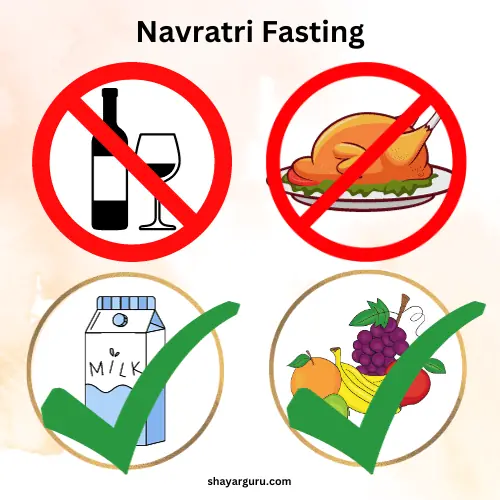
Fasting is a common tradition during Navratri. Many devotees abstain from consuming grains, non-vegetarian food, and alcohol during this period. Instead, they opt for Sattvic (pure and simple) food like fruits, milk, and specific grains. Daily prayers and rituals are performed in homes and temples, dedicated to Goddess Durga. Devotees chant mantras and sing bhajans to seek her blessings.
Garba and Dandiya Raas
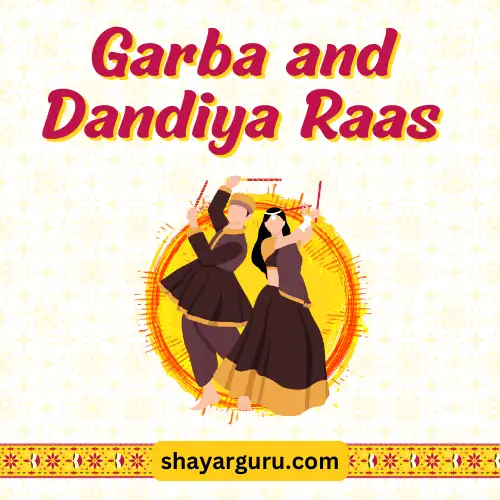
One of the most enjoyable aspects of Navratri is the energetic dance forms called Garba and Dandiya Raas. Garba is a graceful dance in circular formations, while Dandiya Raas involves dancing with wooden sticks. These dances are not just a form of celebration but also a way to express devotion and celebrate the divine.
Navratri Aarti and Prayers
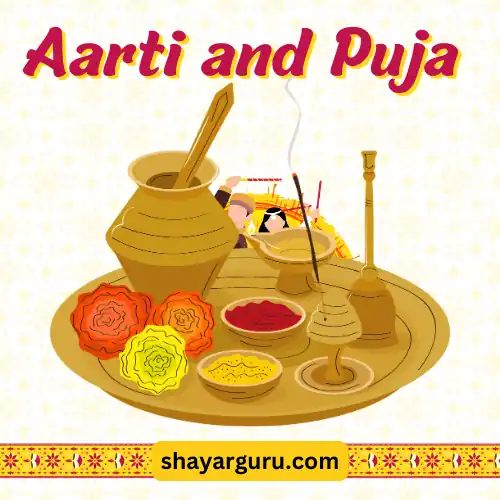
Special aartis (prayer songs) dedicated to Goddess Durga are sung during Navratri. Devotees gather in temples or at home to offer their prayers and seek the blessings of the Goddess. The atmosphere is filled with devotion and spirituality.
You may like to see: नवरात्री हिन्दी शुभकामना संदेश
Kanya Pujan
On the eighth or ninth day of Navratri, a ritual called Kanya Pujan is performed. Young girls, often representing the nine forms of Goddess Durga, are invited to homes and worshipped. Their feet are washed, and they are given gifts and food, symbolizing the honor and reverence for the divine feminine energy.
Fasting Rules and Guidelines
Fasting during Navratri is an essential aspect of the festival. Devotees abstain from consuming certain foods, particularly grains and non-vegetarian items. The fasting rules can vary from region to region and person to person. However, the focus remains on consuming Sattvic food that is considered pure and spiritually beneficial.
Sattvic Food: A Key Element
Sattvic food, which is considered pure and balanced, plays a crucial role during Navratri. It includes fruits, dairy products, nuts, and specific grains like amaranth and water chestnut flour. These foods are believed to promote purity of mind and body, aligning with the spiritual goals of the festival.
Popular Navratri Dishes
- Sabudana Khichdi: Made from tapioca pearls, this dish is a fasting favorite and is seasoned with cumin, green chilies, and peanuts.
- Kuttu Ki Puri: These crispy, unleavened buckwheat flour puris are a staple during Navratri fasting.
- Singhare Ke Atte Ka Samosa: Samosas made from water chestnut flour are a delicious treat.
- Makhana (Fox Nuts): Roasted makhana is a popular snack.
- Fruit Chaat: A refreshing mix of fruits with a sprinkle of rock salt and black pepper.
- Sama Rice Khichdi: Made from barnyard millet, this khichdi is simple and nutritious.
Regional Variations
Different regions of India have their own unique dishes and variations of fasting food. For instance, in Gujarat, you’ll find dishes like Kachori and Fafda, while in Bengal, sweets like Sandesh and Mishti Doi are preferred. These regional specialties add diversity and flavor to Navratri fasting.
Discover More: Dussehra Wishes in Hindi
Why is Navratri celebrated?
Navratri is celebrated to honor Goddess Durga and commemorate her victory over the demon Mahishasura, symbolizing the triumph of good over evil.
When does Navratri occur each year?
Navratri is celebrated four times a year, with Sharad Navratri being the most popular. The dates are determined by the lunar calendar and usually fall in March/April (Chaitra Navratri), July/August (Ashad Navratri), September/October (Sharad Navratri), and January/February (Magha Navratri).
What is the significance of the nine nights?
The nine nights of Navratri represent the nine divine forms or manifestations of Goddess Durga, each with its unique significance and attributes.
What are some common Navratri prayers?
Common Navratri prayers include the chanting of the Durga Chalisa, the recitation of specific mantras, and singing bhajans dedicated to Goddess Durga.
How do people celebrate Navratri in different regions?
Navratri is celebrated with variations in different regions of India. For example, in Gujarat, Garba and Dandiya Raas are prominent, while in West Bengal, Durga Puja is the focal point of the festival.
Conclusion
Navratri is a celebration of devotion, spirituality, and cultural diversity. It brings people together to worship Goddess Durga and celebrate the victory of good over evil. The traditions, fasting rituals, vibrant dances, and delicious Sattvic food make Navratri a cherished and joyous festival. As devotees come together to seek the blessings of the divine, they also strengthen the bonds of family and community, making Navratri an integral part of India’s rich cultural tapestry.
If you found this article about the Navratri festival informative and enjoyable, we encourage you to share it with your loved ones and connect with us on Twitter, Facebook, and Google News. Wishing everyone a festive and joyous Navratri celebration!